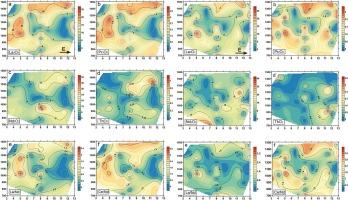Spatial distribution and chemical characteristics of bastnäsite and monazite provide insights into the Bayan Obo deposit, the world's largest rare earth element mineralization
IF 2.5
2区 地球科学
Q2 GEOCHEMISTRY & GEOPHYSICS
引用次数: 0
Abstract
Bastnäsite and monazite are the main carriers of thorium (Th) and rare earth elements (REEs) in Bayan Obo, the world's largest REE deposit. Understanding the spatial distribution of their chemical compositions is crucial for deciphering mineralization processes and improving resource utilization. Meanwhile, the precise mechanisms by which Th enters the lattice of these minerals remain poorly understood. Petrographic studies reveal that bastnäsite and monazite predominantly occur as fine-grained (<50 μm) aggregates, classified into three distinct paragenetic types: associated only with dolomite (Bsn/Mnz-I), associated with fluorite (Bsn/Mnz-II), and associated with alkali silicate minerals (Bsn/Mnz-III). Th4+ enters the lattice of all types of bastnäsite through Th4++(Ca, Ba)2+ → 2ΣREE3+. In contrast, monazite exhibits distinct Th4+ incorporation mechanisms depending on its type. Specifically, Th4+ is incorporated in Mnz-I exclusively through cheralite substitution (Th4+ + Ca2+ → 2REE3+), while in Mnz-II and Mnz-III, it involves cheralite (Th4++Ca2+ → 2REE3+) and huttonite (Th4++Si4+ → REE3++P5+) substitutions. Our data also show that the chemical composition of bastnäsite and monazite within the Main Orebody is highly heterogeneous, exhibiting a tendency towards enrichment in La2O3 and Pr2O3 and depletion in ThO2 and Nd2O3 from the deep eastern part to the shallow western part of the Main Orebody. Based on the metallogenic temperature, mineralized materials, and REE migration characteristics, it is inferred that the ore-forming hydrothermal fluids originate from the eastern depths of the Main Orebody and subsequently migrate upwards towards the western domain.

bastnäsite和独居石的空间分布和化学特征为认识世界上最大的稀土元素矿——巴彦鄂博矿床提供了新的视角
Bastnäsite和独居石是世界上最大的稀土矿床白云鄂博钍(Th)和稀土元素(REE)的主要载体。了解其化学成分的空间分布,对于破译成矿过程和提高资源利用水平具有重要意义。与此同时,人们对Th进入这些矿物晶格的确切机制仍然知之甚少。岩石学研究表明bastnäsite和独居石主要以细粒(<50 μm)集合体形式存在,可分为3种不同的共生类型:仅与白云石(Bsn/Mnz-I)共生,与萤石(Bsn/Mnz-II)共生,与碱硅酸盐矿物(Bsn/Mnz-III)共生。Th4+通过Th4++(Ca, Ba)2+→2ΣREE3+进入所有类型bastnäsite的晶格。而独居石则表现出不同类型的Th4+结合机制。具体来说,Th4+在Mnz-I中只通过翡翠石取代(Th4++Ca2+→2REE3+)而在Mnz-II和Mnz-III中则通过翡翠石(Th4++Ca2+→2REE3+)和huttonite (Th4++Si4+→REE3++P5+)取代。研究结果还表明,主矿体内bastnäsite和独居石的化学组成具有高度的非均质性,从东部深部到西部浅部呈现La2O3和Pr2O3富集、ThO2和Nd2O3亏缺的趋势。根据成矿温度、成矿物质及稀土元素运移特征,推断成矿热液流体起源于主矿体东部深部,向西域向上运移。
本文章由计算机程序翻译,如有差异,请以英文原文为准。
求助全文
约1分钟内获得全文
求助全文
来源期刊

Lithos
地学-地球化学与地球物理
CiteScore
6.80
自引率
11.40%
发文量
286
审稿时长
3.5 months
期刊介绍:
Lithos publishes original research papers on the petrology, geochemistry and petrogenesis of igneous and metamorphic rocks. Papers on mineralogy/mineral physics related to petrology and petrogenetic problems are also welcomed.
 求助内容:
求助内容: 应助结果提醒方式:
应助结果提醒方式:


